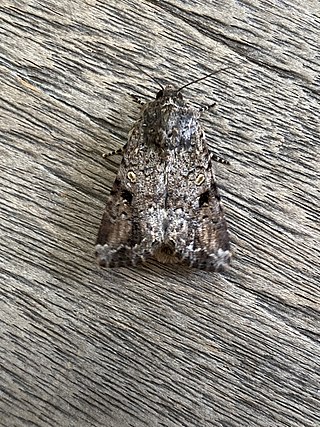
The Noctuidae, commonly known as owlet moths, cutworms or armyworms, are a family of moths. They are considered the most controversial family in the superfamily Noctuoidea because many of the clades are constantly changing, along with the other families of the Noctuoidea. It was considered the largest family in Lepidoptera for a long time, but after regrouping Lymantriinae, Catocalinae and Calpinae within the family Erebidae, the latter holds this title now. Currently, Noctuidae is the second largest family in Noctuoidea, with about 1,089 genera and 11,772 species. This classification is still contingent, as more changes continue to appear between Noctuidae and Erebidae.

Papilio is a genus in the swallowtail butterfly family, Papilionidae, as well as the only representative of the tribe Papilionini. The word papilio is Latin for butterfly.

Jean Baptiste Alphonse Déchauffour de Boisduval was a French lepidopterist, botanist, and physician.

The Sesiidae or clearwing moths are a diurnal moth family in the order Lepidoptera known for their Batesian mimicry in both appearance and behaviour of various Hymenoptera.

The common swift is a moth of the family Hepialidae. It was previously placed in the genus Hepialus. It is a common, often abundant European species. The species was described by Carl Linnaeus in his 1758 10th edition of Systema Naturae.

The genus Scrophularia of the family Scrophulariaceae comprises about 200 species of herbaceous flowering plants commonly known as figworts. Species of Scrophularia all share square stems, opposite leaves and open two-lipped flowers forming clusters at the end of their stems. The genus is found throughout the Northern Hemisphere.

Baccharis is a genus of perennials and shrubs in the aster family (Asteraceae). They are commonly known as baccharises but sometimes referred to as "brooms", because many members have small thin leaves resembling the true brooms. They are not at all related to these however, but belong to an entirely different lineage of eudicots. B. halimifolia is commonly known as "groundsel bush", however true groundsels are found in the genus Senecio.

Phymatopus is a genus of moths of the family Hepialidae, which consists of around 500 species and 30 genera. The genus was erected by Hans Daniel Johan Wallengren in 1869. They can be found across Eurasia and North America. Species can be distinguished by the different morphology of male genitalia and different forewing patterns, which vary in stripe colour and size and arrangement of spots. The stripes themselves consist of spots separated by dark veins which are fringed by thin black lines from both inner and outer sides.

Agrotis is a genus of moths of the family Noctuidae. The genus was erected by Ferdinand Ochsenheimer in 1816. A number of the species of this genus are extinct.

The gold swift is a moth belonging to the family Hepialidae. Until recently it was placed in the genus Hepialus. The species was first described by Carl Linnaeus in his 1758 10th edition of Systema Naturae. Moths of the Hepialidae are considered to be primitive moths; they do not have a proboscis and are unable to feed. The gold swift is a widespread species found in Europe and Asia, including Japan.

Cocytia is a genus of moths in the family Erebidae. It is monotypic, being represented by the single species, Cocytia durvillii, an uncommon day-flying moth found in lowland areas of the Moluccas, Aru, and New Guinea. The species has clear wings bordered with black, with an orange patch at the base of each forewing and long antennae, thicker at the outer end. Both the genus and species were first described by Jean Baptiste Boisduval in 1828.

Spodoptera is a genus of moths of the family Noctuidae erected by Achille Guenée in 1852. Many are known as pest insects. The larvae are sometimes called armyworms. The roughly thirty species are distributed across six continents.

Macroglossum divergens, the broad-bordered hummingbird hawkmoth, is a moth of the family Sphingidae. It was described by Jean Baptiste Boisduval in 1875. It is found from north-eastern Sikkim, India across southern China to Cheju Island, southern Japan, Taiwan and the Philippines and then south through Vietnam, Thailand, Malaysia and Indonesia to New Guinea and neighbouring islands. It may be in Sri Lanka.

Spodoptera mauritia, the lawn armyworm or paddy swarming caterpillar, is a moth of the family Noctuidae. The species was first described by Jean Baptiste Boisduval in 1833. Able to eat many types of food, it is a major pest throughout the world.
Phymatopus japonicus is a species of moth belonging to the family Hepialidae. It was described by Inoue in 1982, and is known from Japan, from which its species epithet is derived. The food plant for this species is Pteridium.
Phymatopus hectica is a species of moth belonging to the family Hepialidae. It was described by Otto Bang-Haas in 1927, and is known from Russia.
Phymatopus californicus, the lupine ghost moth, is a species of moth belonging to the family Hepialidae. It was described by Jean Baptiste Boisduval in 1868 and is known from the US state of California.

Noctuina is a subtribe of cutworm or dart moths in the family Noctuidae. There are at least 170 described species in Noctuina.
Noctuini is a tribe of owlet moths in the family Noctuidae. There are at least 520 described species in Noctuini.














